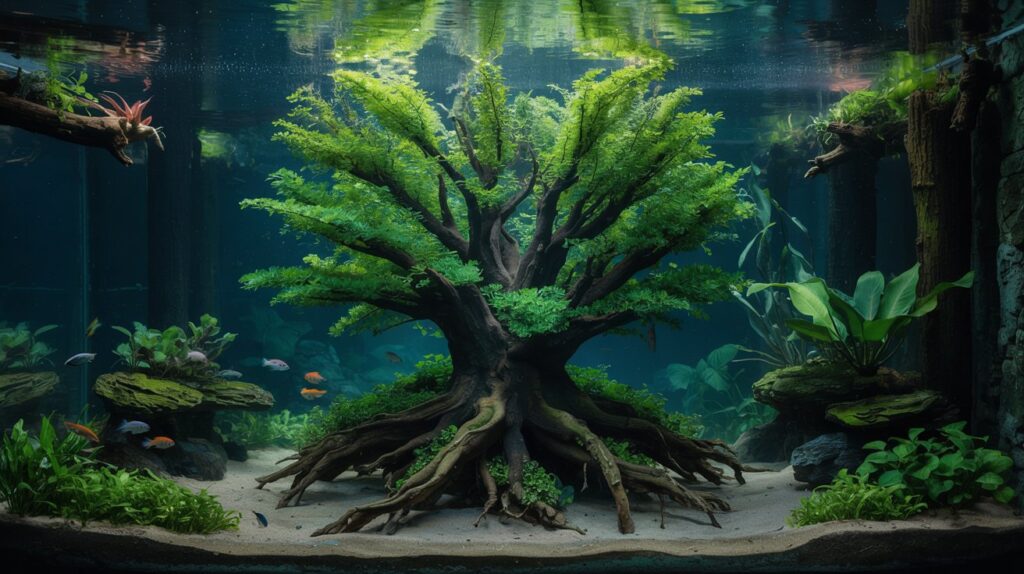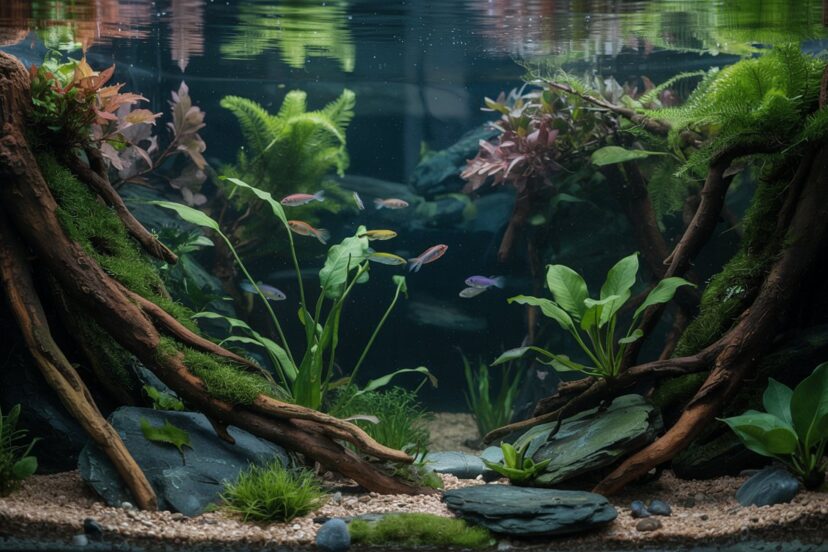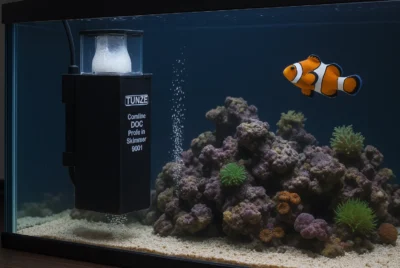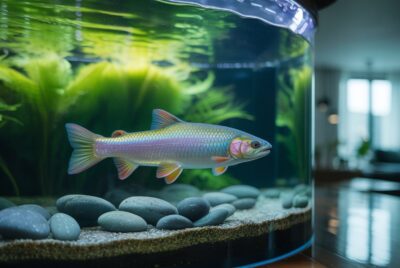The Magic of Forest Aquascape
*We may earn a commission for purchases made using our links. Please see our disclosure to learn more.
I remember the first time I saw a true forest aquascape, it was like peering into another world, a miniature ecosystem where underwater trees reached toward the surface and tiny fish darted through shadowy glens. As someone who’s spent the last decade immersed in the aquascaping community, I’ve watched forest aquascaping evolve from a niche style to one of the most captivating approaches in the hobby. Unlike the strictly geometric Iwagumi or the meticulously organized Dutch styles, forest aquascaping captures something primal and deeply familiar, the feeling of standing in a woodland clearing as light filters through the canopy above.
“The forest aquascape represents our desire to connect with primordial nature. In these miniature underwater forests, we create sanctuaries that speak to something ancient within us.”
— Takashi Amano, Nature Aquarium World (1994)
Key Takeaways
- Forest aquascaping draws inspiration from woodland environments, using vertical elements and lush plantings to create depth and dimension
- Selecting the right combination of hardscape materials (driftwood, rocks) and plants with varying heights is essential for an authentic forest look
- Proper lighting is crucial for highlighting the vertical elements and creating the dappled light effect of a forest canopy
- Maintenance requires regular trimming and attention to plant health to preserve the forest aesthetic
- Forest aquascapes can be created in tanks of various sizes, though larger tanks offer more opportunity for dramatic landscapes
Recommended Forest Aquascape Products
Before diving into the details, here are four products I’ve personally used and highly recommend for anyone looking to create their own forest aquascape:
Fluval Plant and Shrimp Stratum
The Fluval 12694 Plant and Shrimp Stratum is a premium aquarium substrate designed to promote robust plant growth and create an optimal environment for freshwater shrimp. Made from mineral-rich volcanic soil, it enhances root development, supports beneficial bacteria colonization, and helps maintain a neutral to slightly acidic pH—ideal for planted tanks. Its porous structure improves water circulation, while also providing shelter for baby shrimp, making it a great choice for aquascapers and shrimp keepers alike.
- Enhances Plant Growth: Nutrient-rich substrate supports strong root development for lush aquatic plants.
- Supports Beneficial Bacteria: Porous structure encourages the growth of nitrifying bacteria for a healthy tank.
- Ideal for Shrimp & Tropical Fish: Helps maintain a stable, slightly acidic pH suitable for shrimp and plant species.
- Can Cloud Water Initially: Requires rinsing and settling time before achieving full clarity.
- Lightweight Particles: May shift easily when disturbed, especially in high-flow tanks.
- Limited Longevity: Nutrient supply depletes over time, requiring supplementation or replacement.
This specialized substrate provides the perfect foundation for forest-style planted tanks. Its porous structure promotes healthy root development while maintaining optimal pH levels for common aquatic plants. The dark coloration also creates a natural forest floor appearance, enhancing the overall aesthetic.
Jorewood Natural Small Spiderwood Driftwood
Enhance your aquarium or reptile tank with Jorewood Natural Small Spiderwood Driftwood. Each piece is uniquely shaped, adding a natural and artistic touch to your setup. Perfect for aquascaping, these durable and sturdy driftwood branches can be used to create moss trees, hiding spots, or climbing structures for reptiles. Ideal for tanks over 20 gallons, this premium driftwood is carefully selected to ensure quality and long-lasting use.
- Unique Natural Shapes: Each piece has a distinct look, enhancing the aesthetics of your tank.
- Versatile Use: Suitable for aquariums, terrariums, and reptile enclosures.
- Durable & Long-Lasting: High-quality wood withstands both underwater and dry environments.
- Requires Preparation: Needs boiling and soaking to remove tannins before use in fish tanks.
- Size Variation: Natural shapes may differ from the pictures, with some pieces being smaller or larger.
- Can Release Tannins: May slightly tint water if not properly pre-treated.
These intricate, branch-like pieces create the perfect vertical structure for forest aquascapes. Their natural appearance mimics fallen trees and creates excellent attachment points for moss and epiphytes. The complex branching patterns are ideal for creating the impression of tree canopies and understory vegetation.
Finnex Planted+ 24/7 LED Aquarium Light
The Finnex Planted Plus 24/7 HLC Aquarium LED Light is designed to provide a full-spectrum lighting experience, promoting healthy plant growth with its True 660nm Deep Red LEDs. Featuring an automated 24/7 mode, it simulates natural sunrise and sunset transitions, creating a realistic day-night cycle for your aquarium. With a sleek aluminum design and remote-controlled customization, this light is perfect for aquascapers and planted tank enthusiasts looking for both functionality and style.
- Full-Spectrum Lighting: Enhances plant growth with deep red, blue, green, and daylight LEDs.
- 24/7 Automated Mode: Simulates natural sunrise and sunset for a realistic day-night cycle.
- Sleek & Durable Design: Aluminum body provides a polished, modern look while ensuring longevity.
- Remote-Dependent Control: Settings cannot be adjusted manually without the remote.
- Limited Water Resistance: Not fully waterproof, so precautions are needed near water.
- Brightness May Need Adjustment: Some users may find it too bright for low-light plants or sensitive fish.
The customizable lighting settings on this fixture allow you to create the perfect dappled light effect that defines forest environments. Its programmable sunrise/sunset feature helps maintain plant health while creating a natural cycle. The ability to adjust intensity and spectrum makes it particularly valuable for managing the demanding light requirements of different forest aquascape plants.
ADA Aqua Soil Amazonia
The ADA Aqua Soil Amazonia Ver. 2 is a high-quality aquarium substrate made from rare Japanese plant-based black soil, designed to promote healthy aquatic plant growth. It includes a separate Amazon concentrate supplement, enhancing organic nutrients and essential elements. With its natural buffering properties, it helps lower pH and water hardness, creating an ideal environment for a thriving planted tank. The granules are specially designed for optimal root development, making this substrate a great choice for both beginners and advanced aquascapers.
- Rich in Nutrients: Provides essential minerals and organic components for lush plant growth.
- pH & Hardness Control: Naturally buffers water to ideal levels for most aquatic plants.
- Ideal Granule Structure: Promotes strong root development and a natural aesthetic.
- Initial Water Cloudiness: May cause temporary clouding when first added to the tank.
- Requires Maintenance: Can release nutrients that may lead to algae if not properly managed.
- Premium Price: More expensive compared to other aquarium substrates.
Though premium-priced, this nutrient-rich substrate is exceptional for demanding plants often used in forest aquascapes. Its appearance and texture create a natural forest floor look while promoting vibrant growth. The granulated structure allows for easy planting while maintaining excellent water quality parameters.
The Art and Science of Forest Aquascaping
My journey into forest aquascaping began after years of experimenting with other styles. What attracted me most was the sense of depth and mystery that a well-executed forest aquascape creates. Unlike other aquascaping approaches that emphasize open spaces or geometric precision, forest aquascaping embraces a certain complexity and wildness that feels authentic to natural woodland settings.
The philosophy behind forest aquascaping is rooted in biomimicry, the art of imitating natural systems. In nature, forests develop through succession, with pioneering species creating conditions for more complex communities to establish over time. A successful forest aquascape captures this sense of ecological evolution and interconnectedness. The visual density creates hiding places for shy fish, while the variety of plant species supports diverse microhabitats within the aquarium.
Creating Your Foundation
The foundation of any successful forest aquascape lies in its hardscape arrangement. Driftwood pieces serve as the “trees” of your underwater forest, and their placement determines the entire flow and feel of your design. I typically begin by selecting 3-5 main driftwood pieces with interesting branching patterns, positioning them vertically to create the impression of tree trunks reaching toward the surface.
When selecting driftwood, I look for pieces with natural character, knots, hollows, and irregular branching that mimic the imperfections of real trees. Spider wood, Malaysian driftwood, and manzanita branches all work exceptionally well. I avoid perfectly straight pieces, as these rarely occur in nature. Before placing the hardscape, I sketch several possible arrangements, considering the rule of thirds and negative space to create a balanced composition.
The substrate layer plays a dual role in forest aquascaping, providing nutrients for plant growth while creating the appearance of a forest floor. I prefer to create elevation with substrate, building higher areas toward the back of the tank to enhance depth perspective. This dimensional approach allows for the creation of paths and clearings that make your forest feel more authentic and explorable.
For larger tanks, I use substrate supports (foam or plastic dividers) to maintain these elevations without requiring excessive substrate. A mixture of nutrient-rich aqua soil in the planting areas and decorative sand or fine gravel for paths creates visual interest while serving practical purposes. The contrast between planted areas and open pathways draws the eye through the composition, encouraging visual exploration.
Plant Selection and Placement
The magic of forest aquascaping truly comes alive with plant selection. I approach planting in distinct layers, much like a natural forest ecosystem:
For the canopy layer, stem plants with fine leaves create the effect of treetops. Species like Rotala rotundifolia, Limnophila sessiliflora, and Myriophyllum mattogrossense provide that delicate, airy quality that catches water movement beautifully. I plant these toward the back and sides, allowing them to grow tall and occasionally trimming to encourage bushier growth. For a touch of color variation, I’ve had success with Rotala H’ra, which develops stunning red tips under proper lighting, creating the impression of autumn foliage.
The midground layer represents the understory of your forest. Here, plants like Cryptocoryne wendtii, Anubias nana, and various Bucephalandra species thrive. I attach many of these to the driftwood “trunks” using fishing line or cyanoacrylate gel, creating the impression of vegetation growing on forest trees. Hygrophila pinnatifida is another excellent choice for this layer, as its textured leaves and reddish coloration provide contrast against greener species.
The forest floor comes alive with carpet plants such as Marsilea hirsuta, Monte Carlo, or for a different texture, Microsorum pteropus ‘Trident’. These create the impression of ground cover, moss, and small forest floor vegetation. I’ve found that mixing carpet species rather than using a single type creates a more natural appearance, just as forest floors contain multiple ground cover plants.
What truly transformed my forest aquascapes was the liberal use of epiphytes, particularly moss. Java moss, Christmas moss, and flame moss attached to driftwood branches create the appearance of vegetation growing on fallen logs. These details make the scene feel alive and authentic. For a more specialized look, Riccardia chamedryfolia (mini pellia) creates the impression of miniature liverworts growing on forest trees, adding a level of botanical authenticity that impresses even seasoned naturalists.
Microhabitats Within Your Forest

One aspect of forest aquascaping that I find particularly rewarding is the creation of distinct microhabitats within the overall design. Just as real forests contain meadows, streams, and dense thickets, your aquascape can incorporate these variations:
A small clearing with fine sand substrate suggests a forest glade where light penetrates the canopy. Positioning this near the front creates a visual entry point into your aquascape. Surrounding this clearing with shorter plants creates a natural transition.
Creating the impression of a forest stream can be achieved with a winding path of lighter substrate winding through the tank. Placing small rounded stones along its edges enhances the illusion of water-worn pebbles along a woodland creek.
Dead zones, areas with decaying leaves and botanical litter, add authenticity and provide beneficial microorganisms and grazing opportunities for invertebrates. I deliberately add catappa leaves or small seed pods in certain areas to create this effect.
These microhabitats not only enhance the aesthetic appeal but also provide diverse environments for inhabitants, supporting natural behaviors and creating visual interest as fish move between different areas of your underwater forest.
Lighting Your Forest
Lighting creates the mood of your forest aquascape. Unlike other styles that might benefit from uniform, bright lighting, I’ve found forest aquascapes look most natural with slightly dimmer, directional lighting that creates areas of shadow and highlight. This mimics how sunlight filters through a forest canopy.
I prefer LED fixtures that allow customization of color temperature, typically aiming for a slightly warmer spectrum (around 6500K) that brings out the greens while creating a cozy atmosphere. Positioning your light slightly toward the front of the tank helps illuminate the vertical structures while leaving mysterious shadows in the background—exactly like a real forest.
The intensity and duration of lighting should be adjusted based on the specific plants in your arrangement. Most forest aquascapes thrive with 8-10 hours of light daily, with intensity around 50-70 PAR at the substrate level. I’ve experimented with programmable fixtures that simulate dawn and dusk cycles, which not only benefits plant health but creates beautiful viewing opportunities as the tank transitions through different lighting conditions.
Colored lighting should be used judiciously, if at all. While RGB fixtures are popular, I find that subtle enhancements using slightly warmer morning tones and cooler evening tones create a more natural effect than dramatic color shifts. The goal is to highlight the natural colors of your plants and hardscape rather than overwhelming them with artificial hues.
Wildlife Selection
The inhabitants of your forest aquascape should complement its natural feel. I’ve had great success with peaceful schooling fish that move through the “trees” like birds flitting through a forest. Ember tetras, celestial pearl danios, and chili rasboras add flashes of color without overwhelming the scene.
For ground dwellers, consider species that interact with the substrate naturally. Corydoras habrosus or pygmy corydoras create the impression of small creatures foraging on the forest floor. Amano shrimp and nerite snails serve as an excellent clean-up crew while adding movement at various levels of the aquascape.
I’ve found that fish with subtle coloration often work better in forest aquascapes than brightly colored species, which can distract from the natural aesthetic. Species with dappled patterns like certain rasboras or harlequin rasboras echo the dappled light patterns of a forest and integrate beautifully with the overall design.
When selecting fish, consider their behavior in relation to your aquascape’s features. Species that naturally explore different water columns will showcase the vertical dimensions of your forest arrangement. I typically avoid territorial species that might claim certain areas of the tank, disrupting the peaceful forest atmosphere.
Maintenance: Preserving the Forest
Forest aquascapes require a different maintenance approach than other styles. The goal isn’t perfectly manicured rows of plants but rather controlled growth that maintains the forest impression. I perform weekly trimming, focusing on:
- Selectively pruning overgrown stems to maintain the canopy shape
- Removing any decaying leaves that accumulate (just as they would in a forest)
- Gently cleaning moss accumulations that might block light to lower plants
- Maintaining water parameters that favor slow, steady growth rather than rapid expansion
Water changes of 25-30% weekly help maintain clarity while preventing nutrient buildup. I’ve found that slightly lower nitrate levels (around 10ppm) encourage more compact growth in many stem plants, which helps maintain the scale of your forest scene.
Fertilization schedules for forest aquascapes often differ from high-tech planted tanks. I lean toward a lighter dosing regimen that promotes steady rather than explosive growth. This approach maintains the proportions of your design longer between major maintenance sessions. A balance of macronutrients (N, P, K) and micronutrients supports plant health without encouraging excessive growth that could quickly overwhelm your carefully planned forest structure.
Seasonal Variations in Forest Aquascaping
One approach I’ve found particularly rewarding is creating seasonal variations within my forest aquascapes. Just as natural forests change with the seasons, subtle modifications can transform your underwater forest throughout the year:
For a spring forest effect, I increase the proportion of bright green plants and boost lighting slightly to encourage new growth. Adding a few small flowering plants like Pogostemon helferi creates the impression of forest floor flowers.
Summer forests feature denser growth and more intense green colors. I allow stem plants to grow taller during this phase, creating a lush, verdant appearance. Slightly warmer water temperatures (within appropriate ranges for inhabitants) can enhance this seasonal feeling.
Autumn can be suggested by incorporating plants with red and bronze coloration, such as certain Rotala varieties or Ludwigia species. Slightly reducing nitrates while maintaining good phosphate levels often enhances red coloration in many plants.
A winter forest look can be achieved by trimming back growth more significantly and reducing lighting intensity slightly. Plants with silver or glaucous foliage, like certain Bucephalandra varieties, create a cooler winter atmosphere.
These seasonal transitions create a dynamic, evolving aquascape that maintains interest throughout the year while reflecting the natural cycles of woodland environments.
Common Challenges and Solutions
Creating forest aquascapes isn’t without challenges. One persistent issue I’ve faced is the tendency for stem plants to grow too quickly, breaking the scale of the design. I address this by choosing slower-growing species and maintaining slightly lower nutrient levels to control growth rates.
Algae can be particularly problematic in forest arrangements due to the high plant mass and potentially reduced water circulation. I incorporate small powerheads positioned to create gentle movement without disturbing the scene. This, combined with a healthy clean-up crew, helps keep algae at bay.
Perhaps the greatest challenge is patience—forest aquascapes truly improve with age as plants mature and mosses develop their characteristic textures. I’ve learned to resist the urge to constantly adjust and instead allow the system to develop naturally over time.
Conclusion
Forest aquascaping offers a unique opportunity to bring the tranquility and mystery of woodland environments into our homes. Through thoughtful hardscape arrangement, strategic plant selection, and careful maintenance, we can create living underwater forests that evolve and change just like their terrestrial counterparts.
What I find most rewarding about this style is how it connects us to nature in a profound way. As I sit watching the dappled light play through the branches of my aquascape, observing tiny fish darting between “trees,” I feel a sense of peace that’s increasingly rare in our busy world. This, perhaps more than any technical achievement, is the true value of forest aquascaping—creating a window into a natural world that refreshes and restores us.
Whether you’re new to aquascaping or an experienced hobbyist looking for a new challenge, I encourage you to explore the magical world of forest aquascaping. Start small, observe carefully, and let your underwater forest grow into a personal sanctuary that brings the beauty of nature into your daily life.
Frequently Asked Questions
How large should my tank be for a forest aquascape?
While forest aquascapes can be created in nano tanks (as small as 5 gallons), I find that tanks of 20 gallons or larger provide enough space to create true depth and dimension. The vertical nature of forest designs benefits from tanks with greater height—at least 16 inches tall is ideal. However, don’t let tank size discourage you; even a small container can capture the essence of a forest through careful selection of appropriately sized materials.
How do I prevent my forest aquascape from looking too cluttered?
Balance is key in forest aquascaping. I create focal points by ensuring there are “clearings” among the density—areas where the eye can rest. Avoid the temptation to fill every inch with plants or hardscape. Instead, create layers and use negative space deliberately. Periodic thinning of fast-growing plants also helps maintain visual clarity while preserving the forest feel.
What’s the best way to attach plants to driftwood?
For moss and small epiphytes, I use fishing line or cotton thread for temporary attachment—both will eventually dissolve as the plants attach naturally. For larger epiphytes like Anubias or Bucephalandra, cyanoacrylate gel (aquarium-safe super glue) provides immediate, secure attachment. Apply a small dot of glue to the rhizome and press firmly against a textured area of the driftwood for best results.
How do I maintain the forest look as plants grow?
Regular, selective trimming is essential. Unlike other aquascaping styles that might require dramatic pruning, forest maintenance involves frequent small adjustments. I trim stem plants just above a node to encourage branching, creating fuller, bushier growth. For moss, gentle trimming with curved scissors helps maintain its shape without removing too much. The goal is to guide growth rather than strictly control it.
Can I create a forest aquascape with artificial plants?
While natural plants create the most authentic forest appearance and provide biological benefits, quality silk or advanced artificial plants can create a convincing forest aesthetic with significantly reduced maintenance. If using artificial plants, focus on creating natural variability—avoid uniform placement or too-perfect arrangements. Mix different textures and colors, and still use real hardscape materials for authenticity.
















